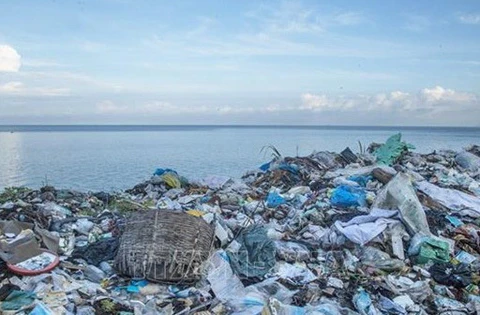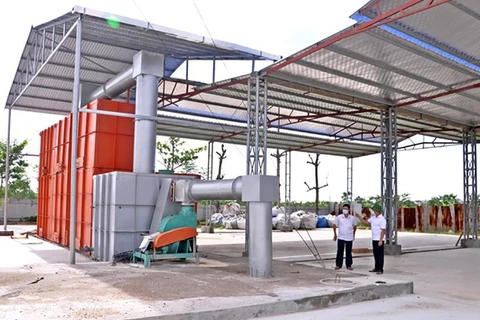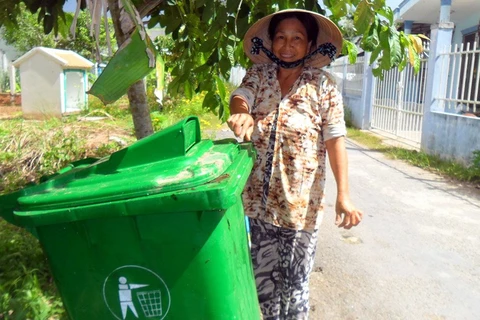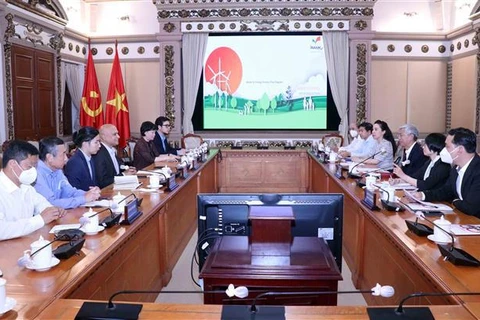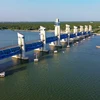 The “Grac” app is being used by waste collectors in HCM City’s Go Vap district, allowing users to call scrap dealers to collect waste, give away junk to the needy, and make online payments for waste collection services. (VNA screenshot)
The “Grac” app is being used by waste collectors in HCM City’s Go Vap district, allowing users to call scrap dealers to collect waste, give away junk to the needy, and make online payments for waste collection services. (VNA screenshot) Bui Hong Son, director of the department’s Information Technology Centre, said applying information technology was an inevitable trend and increasingly popular for environmental protection.
The city generates about 9,500 tonnes of domestic waste each day, equivalent to about 3 million tonnes per year.
Waste management is now quite complicated, involving a set of actions in collection, storage, transporting, treatment, and a final disposal that is environmentally adequate.
Collecting, transporting and treating this huge amount of waste poses challenges to the city authorities, who are seeking to implement advanced technologies to improve performance.
"With the help of technology in waste management, it is possible to quickly detect the processes that generate waste, enable actions to reduce the quantity of waste and the costs associated with shipping and final disposal," he said.
From June, the centre is coordinating with Sai Gon Computer Technology Co. Ltd (CINOTEC) on a pilot programme using the company’s software application called “uberRac” to manage waste.
Nguyen Thanh Trung, director of CINOTEC, said users can download and install this app on their iOS or Android devices to interact with the app’s waste services such as registering for waste collection, paying fees, monitoring garbage truck routes, registering for bulky waste collection and giving feedback on waste services.
The app is being used by private waste collectors in District 7’s Binh Thuan, Tan Quy, Tan Thuan Dong and Tan Thuan Tay wards and is improving sanitation for those residential areas.
Phan Thanh Tung, a senior solution consultant from the Vietnam Informatic and Mapping Corporation, said the firm was developing a digital map for solid waste collection in the city.
"Its features include monitoring the routes, velocity and status of garbage trucks, waste collection points, and waste treatment stations," he said.
Last year, 14 waste collection units in the city’s Go Vap district began to use the “Grac” app developed by Grac Technology JSC.
The move aims to digitise waste management and online payments for waste collection services in the district.
With an online waste market, the app allows scrap dealers and owners of waste to connect. Sellers of waste can take pictures of products they want to sell, such as paper and plastics, and post the images on the app.
Scrap dealers receive information from sellers and then move to the areas where sellers are. The two sides negotiate the prices and make transactions.
Owners can post information about old items they have and want to donate.
Bui Hong Son said this software was expected to revolutionise environment management in the city.
When these software pieces are linked, they will share databases on waste owners, waste transporters, waste treatment organisations, and waste amounts, which will help authorities more efficiently coordinate the process.
This will minimise waste being transported to the wrong location or poorly handled.
Son said the department would also apply the operation model of Open Geospatial Consortium (OGC) as a foundation for natural resources and environment database sharing.
“Via the shared databases, State agencies, private businesses and individuals can easily develop practical software for waste management,” he said.
According to Dean of the Environment Faculty at Van Lang University, Le Thi Kim Oanh, the use of technologies in solid waste treatment brings a lot of benefits.
In Singapore, for example, a chip installed into public trash bins can notify waste collectors when to take waste away.
“Through apps, garbage trucks can identify the shortest route to minimise cost. Better products can be created from waste by using advanced composting technology,” she said.
Applying technologies could also help landfills and incinerators precisely report the concentration of gases released into the air, she added.
The municipal People’s Committee has released the digital transformation plan for natural resources and the environment until 2025 with a direction to 2030.
By 2030, many public services are expected to go online, including all documents for administrative procedures at the city level, except for state secrets.
Among the targets, all observations and measurement equipment in the environment field will produce digital data, and 100% of employees in the environment field will be fully equipped with necessary digital skills./.
VNA
